Effectiveness of MRI in Breast Cancer Screening: Rapid Review
VerifiedAdded on 2022/10/06
|38
|8150
|86
Report
AI Summary
This rapid review examines the effectiveness of Magnetic Resonance Imaging (MRI) in the early diagnosis of breast cancer, specifically focusing on young women and high-risk individuals. The study analyzed systematic reviews and meta-analyses published between 2009 and 2019 to determine if MRI enhances breast cancer detection. The research included studies with women having a family history of breast cancer, prior chest radiation exposure, or genetic mutations like BRCA1/2. The methodology involved searches of databases like MEDLINE, PubMed, Cochrane, EMBASE, and CINAHL, along with quality assessment using AMSTAR. The findings indicate that breast MRI is highly sensitive for breast cancer detection and should be used with mammography. The conclusion emphasizes MRI's effectiveness as a screening and diagnostic tool for breast cancer in young women. The report also provides a detailed background, objectives, inclusion/exclusion criteria, search strategy, methodological details, results, discussion, and implications for practitioners and researchers.
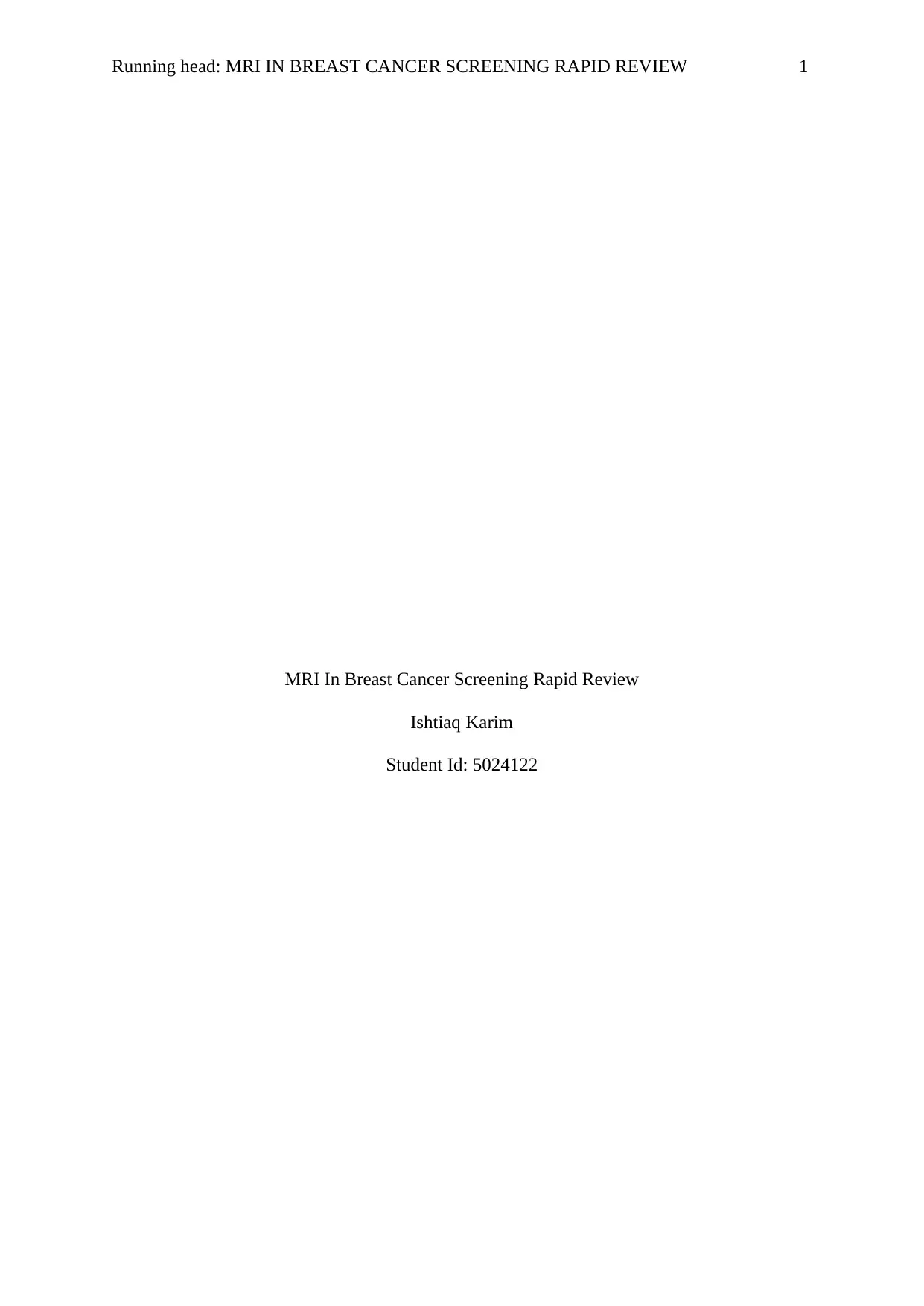
Running head: MRI IN BREAST CANCER SCREENING RAPID REVIEW 1
MRI In Breast Cancer Screening Rapid Review
Ishtiaq Karim
Student Id: 5024122
MRI In Breast Cancer Screening Rapid Review
Ishtiaq Karim
Student Id: 5024122
Paraphrase This Document
Need a fresh take? Get an instant paraphrase of this document with our AI Paraphraser
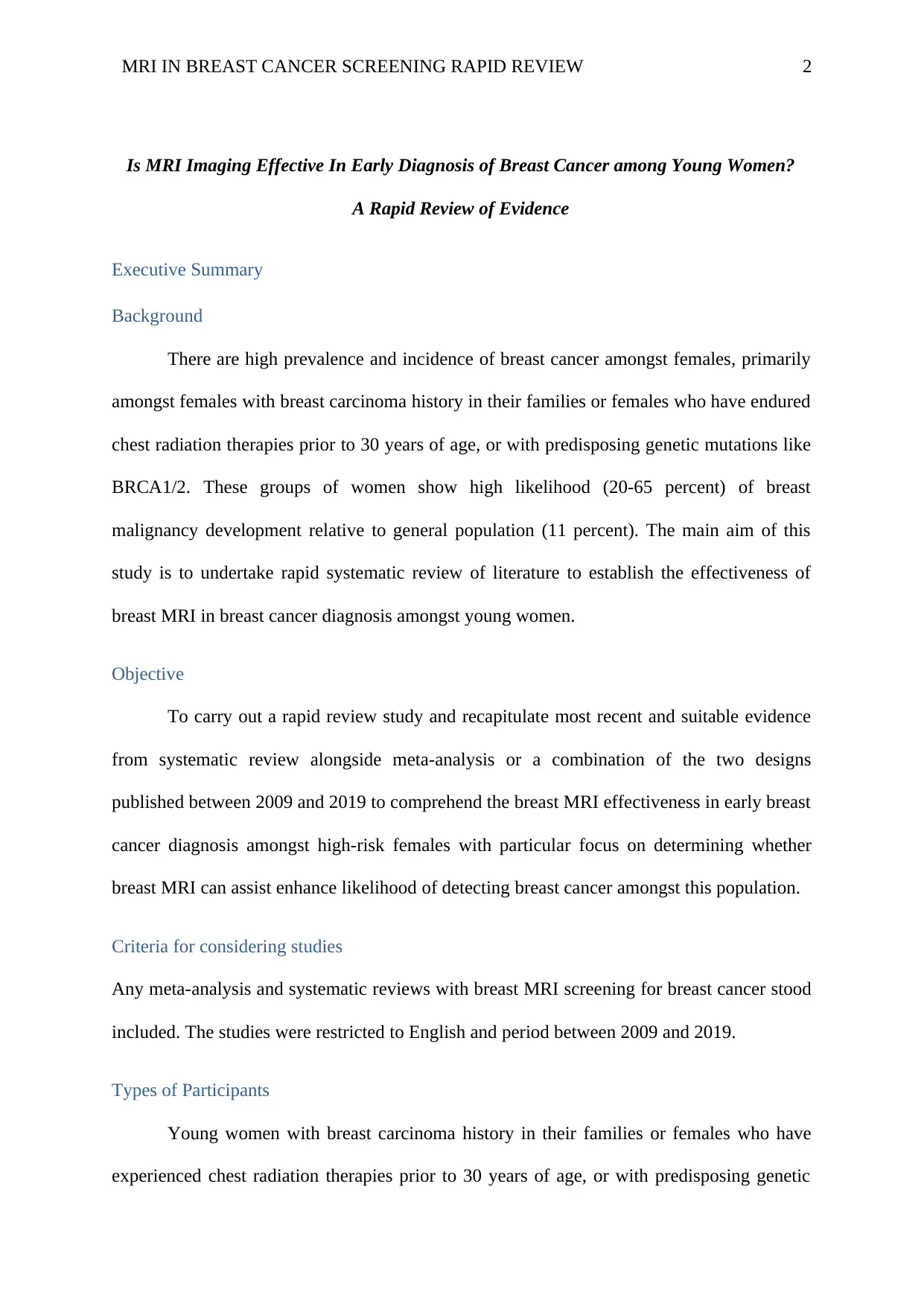
MRI IN BREAST CANCER SCREENING RAPID REVIEW 2
Is MRI Imaging Effective In Early Diagnosis of Breast Cancer among Young Women?
A Rapid Review of Evidence
Executive Summary
Background
There are high prevalence and incidence of breast cancer amongst females, primarily
amongst females with breast carcinoma history in their families or females who have endured
chest radiation therapies prior to 30 years of age, or with predisposing genetic mutations like
BRCA1/2. These groups of women show high likelihood (20-65 percent) of breast
malignancy development relative to general population (11 percent). The main aim of this
study is to undertake rapid systematic review of literature to establish the effectiveness of
breast MRI in breast cancer diagnosis amongst young women.
Objective
To carry out a rapid review study and recapitulate most recent and suitable evidence
from systematic review alongside meta-analysis or a combination of the two designs
published between 2009 and 2019 to comprehend the breast MRI effectiveness in early breast
cancer diagnosis amongst high-risk females with particular focus on determining whether
breast MRI can assist enhance likelihood of detecting breast cancer amongst this population.
Criteria for considering studies
Any meta-analysis and systematic reviews with breast MRI screening for breast cancer stood
included. The studies were restricted to English and period between 2009 and 2019.
Types of Participants
Young women with breast carcinoma history in their families or females who have
experienced chest radiation therapies prior to 30 years of age, or with predisposing genetic
Is MRI Imaging Effective In Early Diagnosis of Breast Cancer among Young Women?
A Rapid Review of Evidence
Executive Summary
Background
There are high prevalence and incidence of breast cancer amongst females, primarily
amongst females with breast carcinoma history in their families or females who have endured
chest radiation therapies prior to 30 years of age, or with predisposing genetic mutations like
BRCA1/2. These groups of women show high likelihood (20-65 percent) of breast
malignancy development relative to general population (11 percent). The main aim of this
study is to undertake rapid systematic review of literature to establish the effectiveness of
breast MRI in breast cancer diagnosis amongst young women.
Objective
To carry out a rapid review study and recapitulate most recent and suitable evidence
from systematic review alongside meta-analysis or a combination of the two designs
published between 2009 and 2019 to comprehend the breast MRI effectiveness in early breast
cancer diagnosis amongst high-risk females with particular focus on determining whether
breast MRI can assist enhance likelihood of detecting breast cancer amongst this population.
Criteria for considering studies
Any meta-analysis and systematic reviews with breast MRI screening for breast cancer stood
included. The studies were restricted to English and period between 2009 and 2019.
Types of Participants
Young women with breast carcinoma history in their families or females who have
experienced chest radiation therapies prior to 30 years of age, or with predisposing genetic
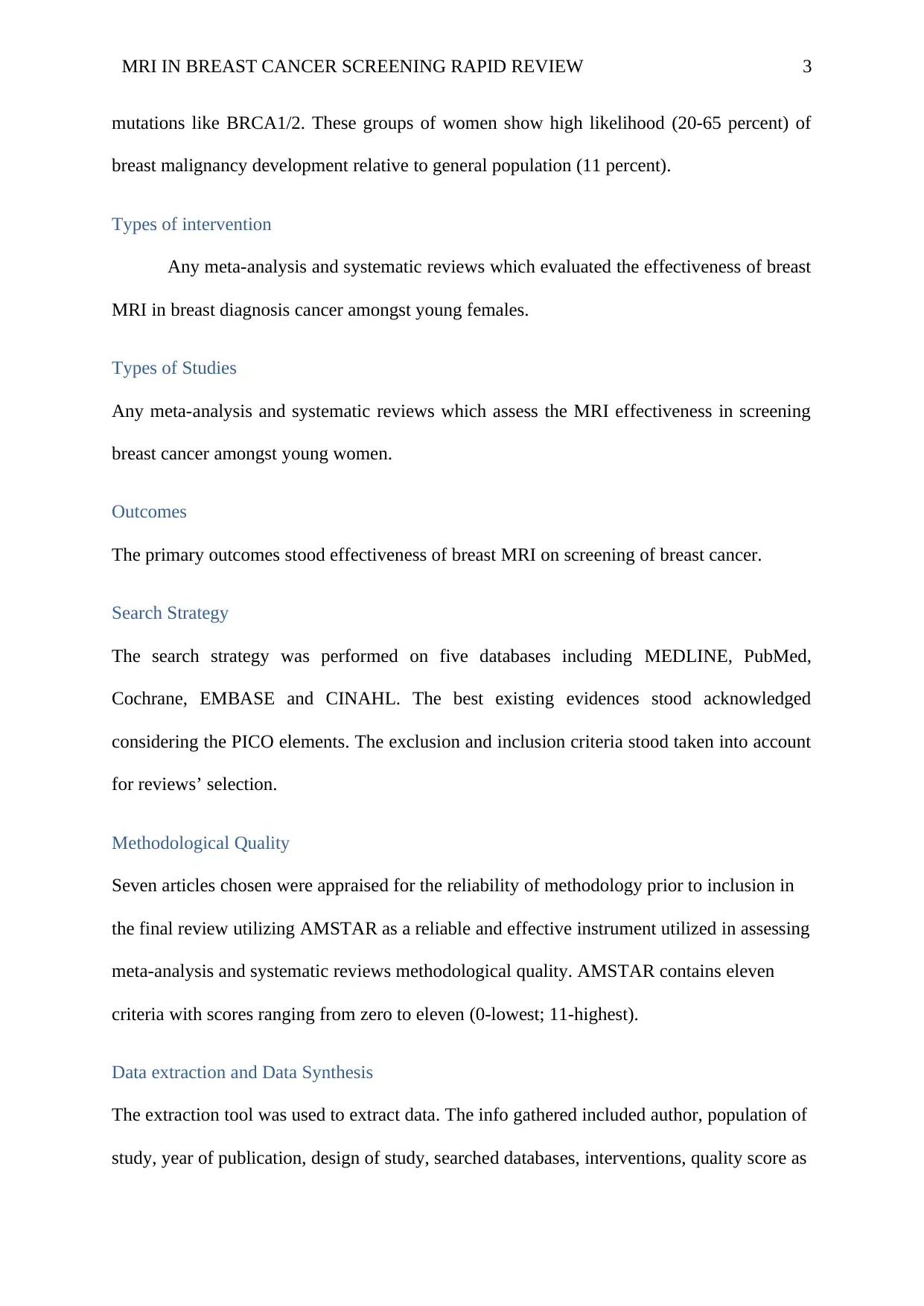
MRI IN BREAST CANCER SCREENING RAPID REVIEW 3
mutations like BRCA1/2. These groups of women show high likelihood (20-65 percent) of
breast malignancy development relative to general population (11 percent).
Types of intervention
Any meta-analysis and systematic reviews which evaluated the effectiveness of breast
MRI in breast diagnosis cancer amongst young females.
Types of Studies
Any meta-analysis and systematic reviews which assess the MRI effectiveness in screening
breast cancer amongst young women.
Outcomes
The primary outcomes stood effectiveness of breast MRI on screening of breast cancer.
Search Strategy
The search strategy was performed on five databases including MEDLINE, PubMed,
Cochrane, EMBASE and CINAHL. The best existing evidences stood acknowledged
considering the PICO elements. The exclusion and inclusion criteria stood taken into account
for reviews’ selection.
Methodological Quality
Seven articles chosen were appraised for the reliability of methodology prior to inclusion in
the final review utilizing AMSTAR as a reliable and effective instrument utilized in assessing
meta-analysis and systematic reviews methodological quality. AMSTAR contains eleven
criteria with scores ranging from zero to eleven (0-lowest; 11-highest).
Data extraction and Data Synthesis
The extraction tool was used to extract data. The info gathered included author, population of
study, year of publication, design of study, searched databases, interventions, quality score as
mutations like BRCA1/2. These groups of women show high likelihood (20-65 percent) of
breast malignancy development relative to general population (11 percent).
Types of intervention
Any meta-analysis and systematic reviews which evaluated the effectiveness of breast
MRI in breast diagnosis cancer amongst young females.
Types of Studies
Any meta-analysis and systematic reviews which assess the MRI effectiveness in screening
breast cancer amongst young women.
Outcomes
The primary outcomes stood effectiveness of breast MRI on screening of breast cancer.
Search Strategy
The search strategy was performed on five databases including MEDLINE, PubMed,
Cochrane, EMBASE and CINAHL. The best existing evidences stood acknowledged
considering the PICO elements. The exclusion and inclusion criteria stood taken into account
for reviews’ selection.
Methodological Quality
Seven articles chosen were appraised for the reliability of methodology prior to inclusion in
the final review utilizing AMSTAR as a reliable and effective instrument utilized in assessing
meta-analysis and systematic reviews methodological quality. AMSTAR contains eleven
criteria with scores ranging from zero to eleven (0-lowest; 11-highest).
Data extraction and Data Synthesis
The extraction tool was used to extract data. The info gathered included author, population of
study, year of publication, design of study, searched databases, interventions, quality score as
⊘ This is a preview!⊘
Do you want full access?
Subscribe today to unlock all pages.

Trusted by 1+ million students worldwide
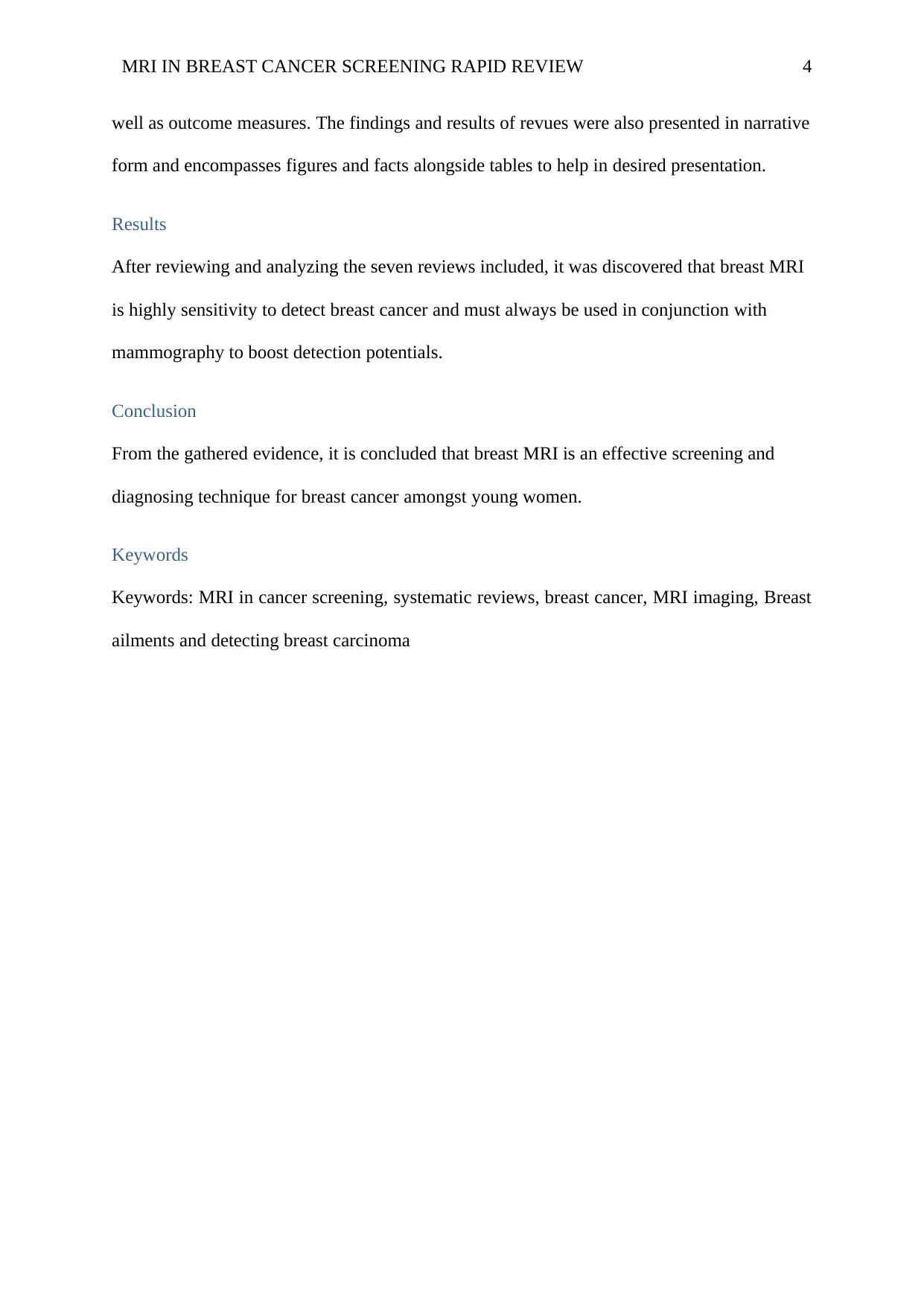
MRI IN BREAST CANCER SCREENING RAPID REVIEW 4
well as outcome measures. The findings and results of revues were also presented in narrative
form and encompasses figures and facts alongside tables to help in desired presentation.
Results
After reviewing and analyzing the seven reviews included, it was discovered that breast MRI
is highly sensitivity to detect breast cancer and must always be used in conjunction with
mammography to boost detection potentials.
Conclusion
From the gathered evidence, it is concluded that breast MRI is an effective screening and
diagnosing technique for breast cancer amongst young women.
Keywords
Keywords: MRI in cancer screening, systematic reviews, breast cancer, MRI imaging, Breast
ailments and detecting breast carcinoma
well as outcome measures. The findings and results of revues were also presented in narrative
form and encompasses figures and facts alongside tables to help in desired presentation.
Results
After reviewing and analyzing the seven reviews included, it was discovered that breast MRI
is highly sensitivity to detect breast cancer and must always be used in conjunction with
mammography to boost detection potentials.
Conclusion
From the gathered evidence, it is concluded that breast MRI is an effective screening and
diagnosing technique for breast cancer amongst young women.
Keywords
Keywords: MRI in cancer screening, systematic reviews, breast cancer, MRI imaging, Breast
ailments and detecting breast carcinoma
Paraphrase This Document
Need a fresh take? Get an instant paraphrase of this document with our AI Paraphraser
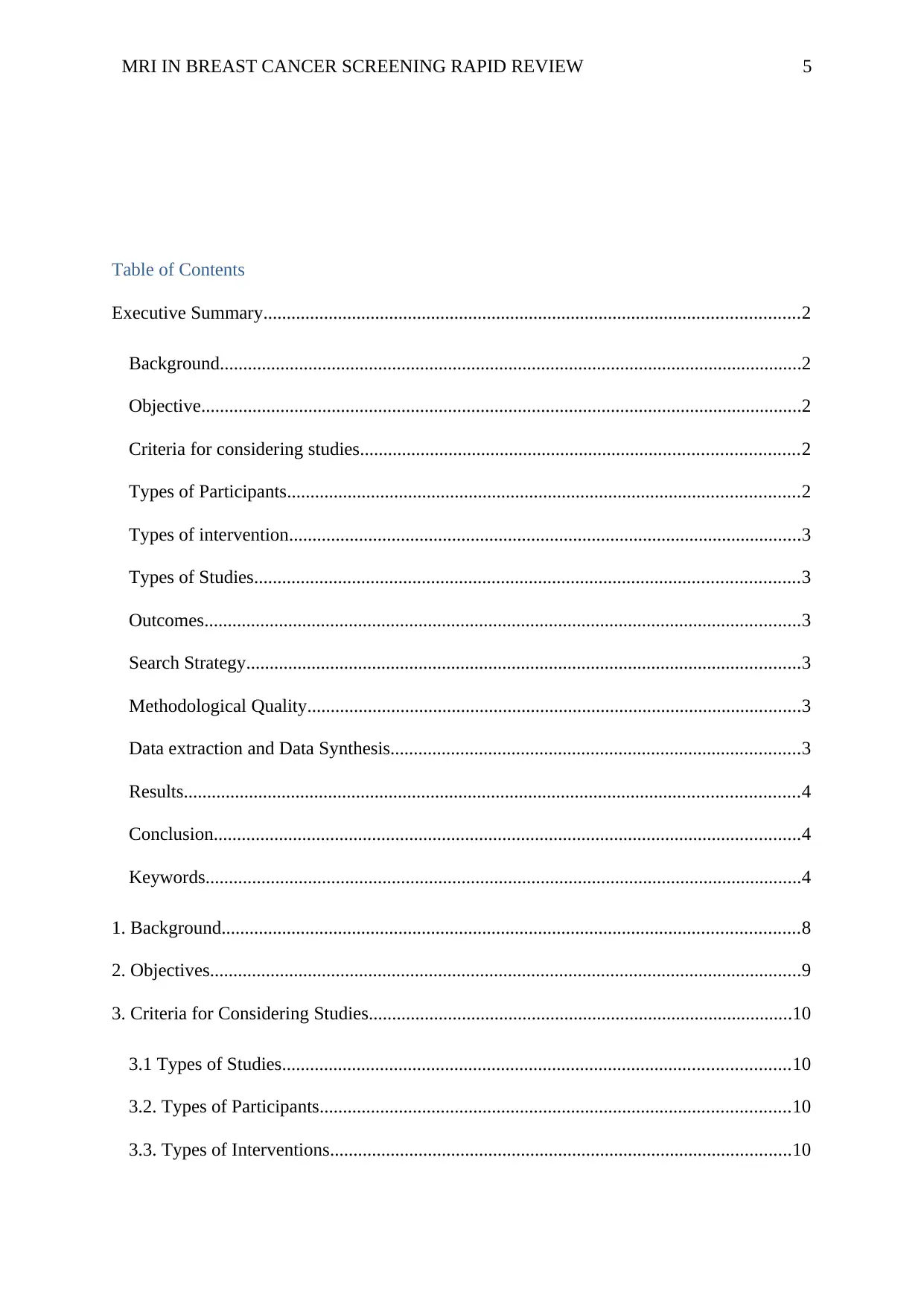
MRI IN BREAST CANCER SCREENING RAPID REVIEW 5
Table of Contents
Executive Summary...................................................................................................................2
Background.............................................................................................................................2
Objective.................................................................................................................................2
Criteria for considering studies..............................................................................................2
Types of Participants..............................................................................................................2
Types of intervention..............................................................................................................3
Types of Studies.....................................................................................................................3
Outcomes................................................................................................................................3
Search Strategy.......................................................................................................................3
Methodological Quality..........................................................................................................3
Data extraction and Data Synthesis........................................................................................3
Results....................................................................................................................................4
Conclusion..............................................................................................................................4
Keywords................................................................................................................................4
1. Background............................................................................................................................8
2. Objectives...............................................................................................................................9
3. Criteria for Considering Studies...........................................................................................10
3.1 Types of Studies.............................................................................................................10
3.2. Types of Participants.....................................................................................................10
3.3. Types of Interventions...................................................................................................10
Table of Contents
Executive Summary...................................................................................................................2
Background.............................................................................................................................2
Objective.................................................................................................................................2
Criteria for considering studies..............................................................................................2
Types of Participants..............................................................................................................2
Types of intervention..............................................................................................................3
Types of Studies.....................................................................................................................3
Outcomes................................................................................................................................3
Search Strategy.......................................................................................................................3
Methodological Quality..........................................................................................................3
Data extraction and Data Synthesis........................................................................................3
Results....................................................................................................................................4
Conclusion..............................................................................................................................4
Keywords................................................................................................................................4
1. Background............................................................................................................................8
2. Objectives...............................................................................................................................9
3. Criteria for Considering Studies...........................................................................................10
3.1 Types of Studies.............................................................................................................10
3.2. Types of Participants.....................................................................................................10
3.3. Types of Interventions...................................................................................................10
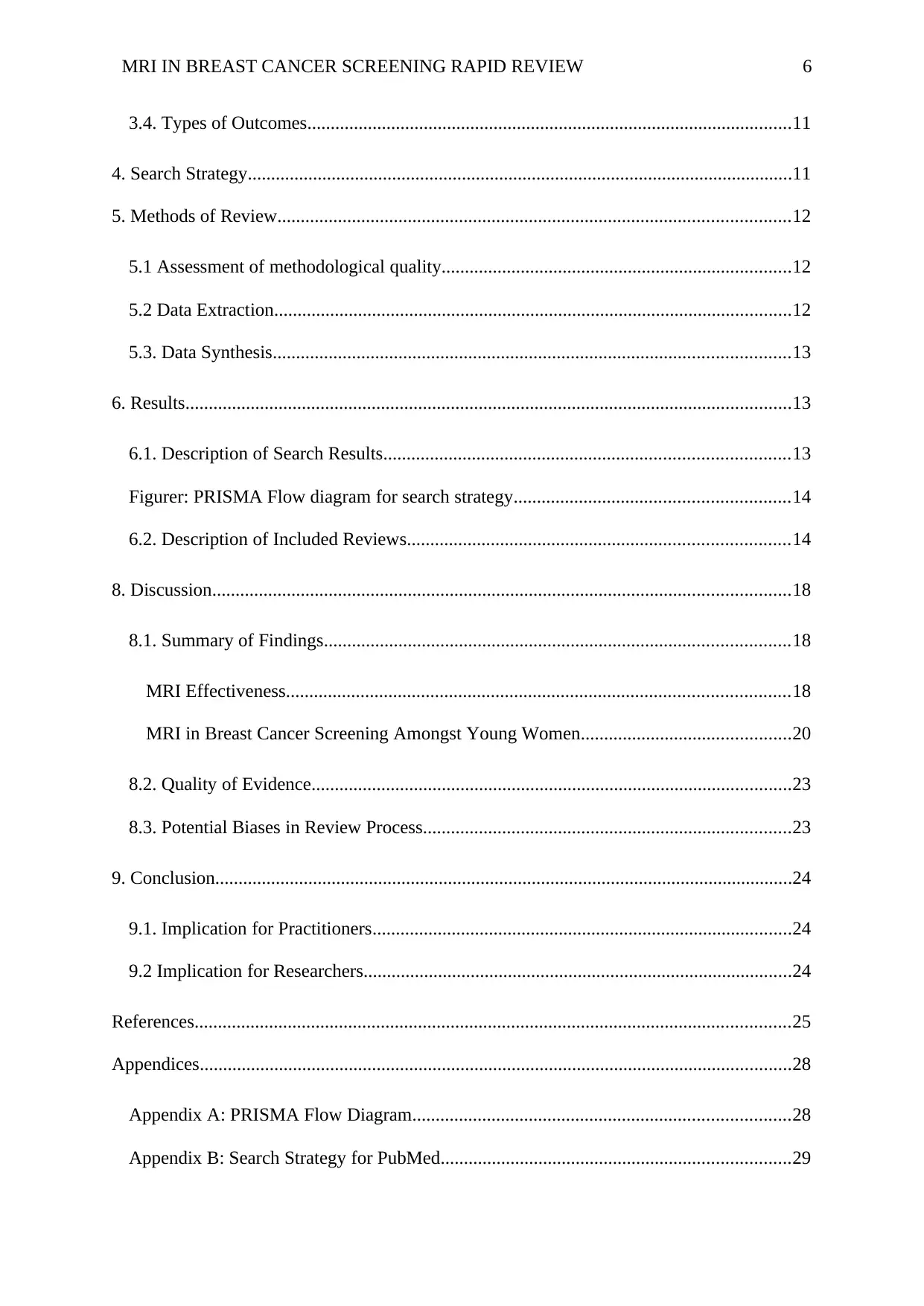
MRI IN BREAST CANCER SCREENING RAPID REVIEW 6
3.4. Types of Outcomes........................................................................................................11
4. Search Strategy.....................................................................................................................11
5. Methods of Review..............................................................................................................12
5.1 Assessment of methodological quality...........................................................................12
5.2 Data Extraction...............................................................................................................12
5.3. Data Synthesis...............................................................................................................13
6. Results..................................................................................................................................13
6.1. Description of Search Results.......................................................................................13
Figurer: PRISMA Flow diagram for search strategy...........................................................14
6.2. Description of Included Reviews..................................................................................14
8. Discussion............................................................................................................................18
8.1. Summary of Findings....................................................................................................18
MRI Effectiveness............................................................................................................18
MRI in Breast Cancer Screening Amongst Young Women.............................................20
8.2. Quality of Evidence.......................................................................................................23
8.3. Potential Biases in Review Process...............................................................................23
9. Conclusion............................................................................................................................24
9.1. Implication for Practitioners..........................................................................................24
9.2 Implication for Researchers............................................................................................24
References................................................................................................................................25
Appendices...............................................................................................................................28
Appendix A: PRISMA Flow Diagram.................................................................................28
Appendix B: Search Strategy for PubMed...........................................................................29
3.4. Types of Outcomes........................................................................................................11
4. Search Strategy.....................................................................................................................11
5. Methods of Review..............................................................................................................12
5.1 Assessment of methodological quality...........................................................................12
5.2 Data Extraction...............................................................................................................12
5.3. Data Synthesis...............................................................................................................13
6. Results..................................................................................................................................13
6.1. Description of Search Results.......................................................................................13
Figurer: PRISMA Flow diagram for search strategy...........................................................14
6.2. Description of Included Reviews..................................................................................14
8. Discussion............................................................................................................................18
8.1. Summary of Findings....................................................................................................18
MRI Effectiveness............................................................................................................18
MRI in Breast Cancer Screening Amongst Young Women.............................................20
8.2. Quality of Evidence.......................................................................................................23
8.3. Potential Biases in Review Process...............................................................................23
9. Conclusion............................................................................................................................24
9.1. Implication for Practitioners..........................................................................................24
9.2 Implication for Researchers............................................................................................24
References................................................................................................................................25
Appendices...............................................................................................................................28
Appendix A: PRISMA Flow Diagram.................................................................................28
Appendix B: Search Strategy for PubMed...........................................................................29
⊘ This is a preview!⊘
Do you want full access?
Subscribe today to unlock all pages.

Trusted by 1+ million students worldwide

MRI IN BREAST CANCER SCREENING RAPID REVIEW 7
Appendix C: Data extraction Form......................................................................................30
Appendix D: AMSTAR 2 Critical Appraisal Form.............................................................32
Appendix E: Time Frame.....................................................................................................37
Appendix C: Data extraction Form......................................................................................30
Appendix D: AMSTAR 2 Critical Appraisal Form.............................................................32
Appendix E: Time Frame.....................................................................................................37
Paraphrase This Document
Need a fresh take? Get an instant paraphrase of this document with our AI Paraphraser
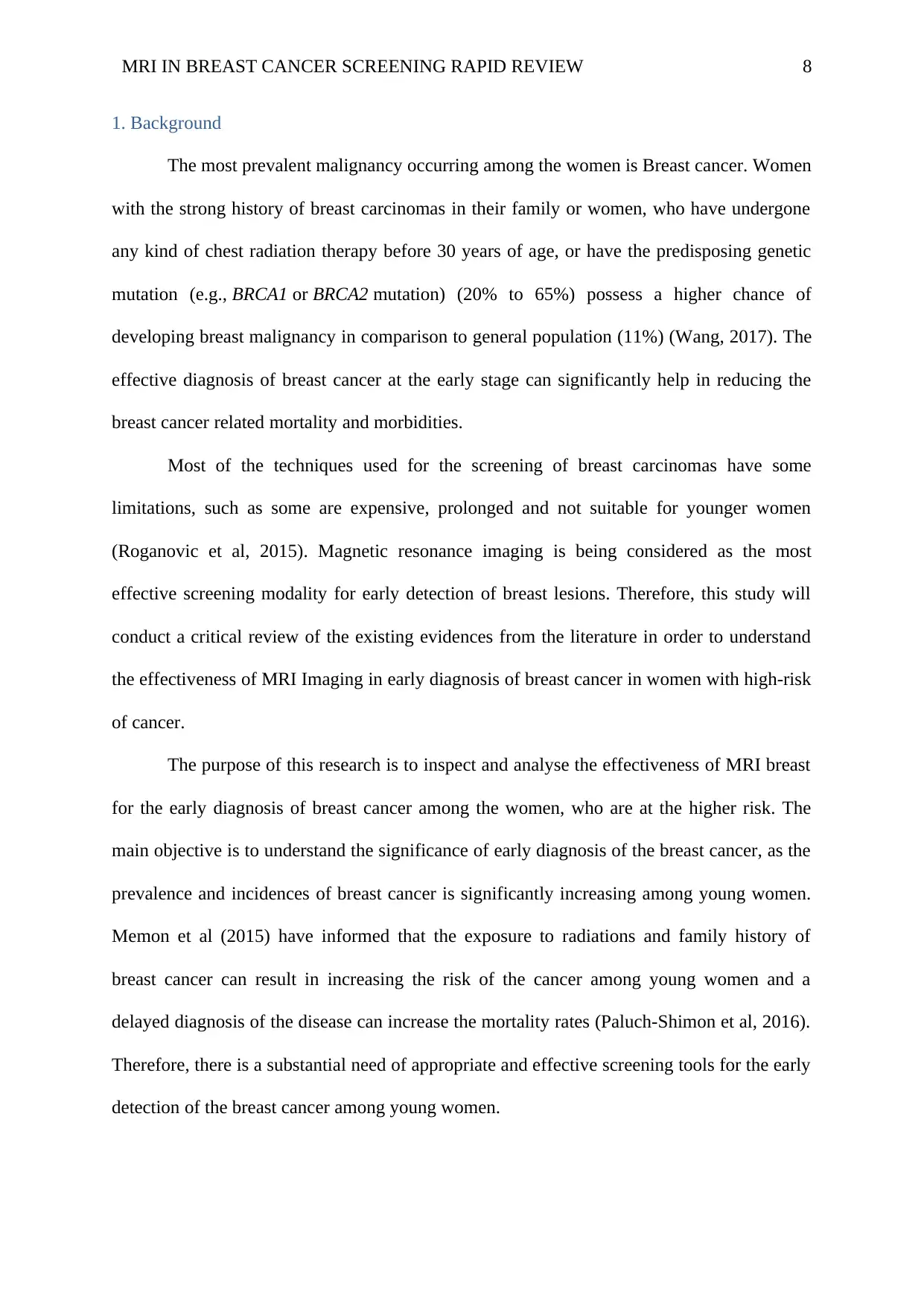
MRI IN BREAST CANCER SCREENING RAPID REVIEW 8
1. Background
The most prevalent malignancy occurring among the women is Breast cancer. Women
with the strong history of breast carcinomas in their family or women, who have undergone
any kind of chest radiation therapy before 30 years of age, or have the predisposing genetic
mutation (e.g., BRCA1 or BRCA2 mutation) (20% to 65%) possess a higher chance of
developing breast malignancy in comparison to general population (11%) (Wang, 2017). The
effective diagnosis of breast cancer at the early stage can significantly help in reducing the
breast cancer related mortality and morbidities.
Most of the techniques used for the screening of breast carcinomas have some
limitations, such as some are expensive, prolonged and not suitable for younger women
(Roganovic et al, 2015). Magnetic resonance imaging is being considered as the most
effective screening modality for early detection of breast lesions. Therefore, this study will
conduct a critical review of the existing evidences from the literature in order to understand
the effectiveness of MRI Imaging in early diagnosis of breast cancer in women with high-risk
of cancer.
The purpose of this research is to inspect and analyse the effectiveness of MRI breast
for the early diagnosis of breast cancer among the women, who are at the higher risk. The
main objective is to understand the significance of early diagnosis of the breast cancer, as the
prevalence and incidences of breast cancer is significantly increasing among young women.
Memon et al (2015) have informed that the exposure to radiations and family history of
breast cancer can result in increasing the risk of the cancer among young women and a
delayed diagnosis of the disease can increase the mortality rates (Paluch-Shimon et al, 2016).
Therefore, there is a substantial need of appropriate and effective screening tools for the early
detection of the breast cancer among young women.
1. Background
The most prevalent malignancy occurring among the women is Breast cancer. Women
with the strong history of breast carcinomas in their family or women, who have undergone
any kind of chest radiation therapy before 30 years of age, or have the predisposing genetic
mutation (e.g., BRCA1 or BRCA2 mutation) (20% to 65%) possess a higher chance of
developing breast malignancy in comparison to general population (11%) (Wang, 2017). The
effective diagnosis of breast cancer at the early stage can significantly help in reducing the
breast cancer related mortality and morbidities.
Most of the techniques used for the screening of breast carcinomas have some
limitations, such as some are expensive, prolonged and not suitable for younger women
(Roganovic et al, 2015). Magnetic resonance imaging is being considered as the most
effective screening modality for early detection of breast lesions. Therefore, this study will
conduct a critical review of the existing evidences from the literature in order to understand
the effectiveness of MRI Imaging in early diagnosis of breast cancer in women with high-risk
of cancer.
The purpose of this research is to inspect and analyse the effectiveness of MRI breast
for the early diagnosis of breast cancer among the women, who are at the higher risk. The
main objective is to understand the significance of early diagnosis of the breast cancer, as the
prevalence and incidences of breast cancer is significantly increasing among young women.
Memon et al (2015) have informed that the exposure to radiations and family history of
breast cancer can result in increasing the risk of the cancer among young women and a
delayed diagnosis of the disease can increase the mortality rates (Paluch-Shimon et al, 2016).
Therefore, there is a substantial need of appropriate and effective screening tools for the early
detection of the breast cancer among young women.
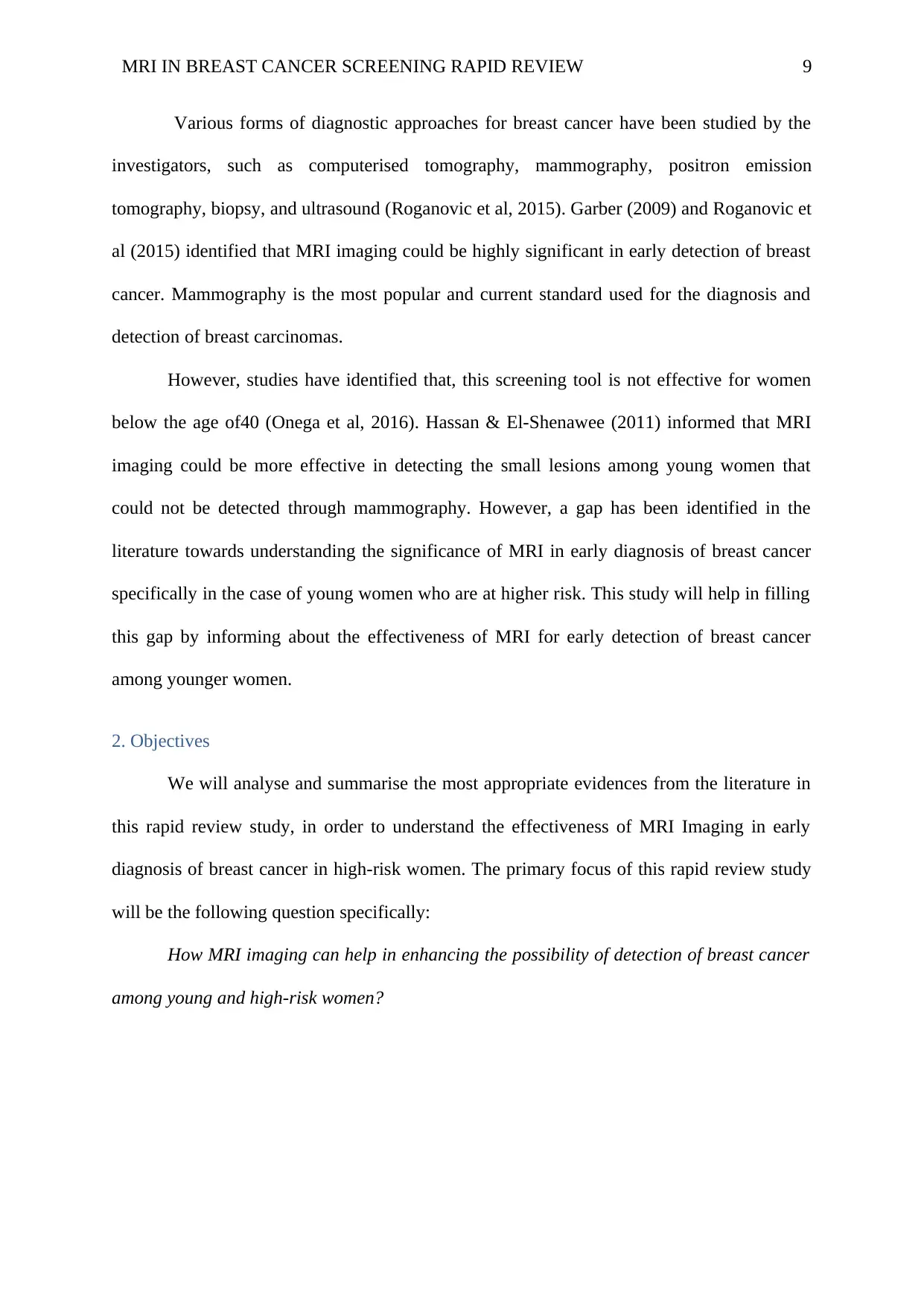
MRI IN BREAST CANCER SCREENING RAPID REVIEW 9
Various forms of diagnostic approaches for breast cancer have been studied by the
investigators, such as computerised tomography, mammography, positron emission
tomography, biopsy, and ultrasound (Roganovic et al, 2015). Garber (2009) and Roganovic et
al (2015) identified that MRI imaging could be highly significant in early detection of breast
cancer. Mammography is the most popular and current standard used for the diagnosis and
detection of breast carcinomas.
However, studies have identified that, this screening tool is not effective for women
below the age of40 (Onega et al, 2016). Hassan & El-Shenawee (2011) informed that MRI
imaging could be more effective in detecting the small lesions among young women that
could not be detected through mammography. However, a gap has been identified in the
literature towards understanding the significance of MRI in early diagnosis of breast cancer
specifically in the case of young women who are at higher risk. This study will help in filling
this gap by informing about the effectiveness of MRI for early detection of breast cancer
among younger women.
2. Objectives
We will analyse and summarise the most appropriate evidences from the literature in
this rapid review study, in order to understand the effectiveness of MRI Imaging in early
diagnosis of breast cancer in high-risk women. The primary focus of this rapid review study
will be the following question specifically:
How MRI imaging can help in enhancing the possibility of detection of breast cancer
among young and high-risk women?
Various forms of diagnostic approaches for breast cancer have been studied by the
investigators, such as computerised tomography, mammography, positron emission
tomography, biopsy, and ultrasound (Roganovic et al, 2015). Garber (2009) and Roganovic et
al (2015) identified that MRI imaging could be highly significant in early detection of breast
cancer. Mammography is the most popular and current standard used for the diagnosis and
detection of breast carcinomas.
However, studies have identified that, this screening tool is not effective for women
below the age of40 (Onega et al, 2016). Hassan & El-Shenawee (2011) informed that MRI
imaging could be more effective in detecting the small lesions among young women that
could not be detected through mammography. However, a gap has been identified in the
literature towards understanding the significance of MRI in early diagnosis of breast cancer
specifically in the case of young women who are at higher risk. This study will help in filling
this gap by informing about the effectiveness of MRI for early detection of breast cancer
among younger women.
2. Objectives
We will analyse and summarise the most appropriate evidences from the literature in
this rapid review study, in order to understand the effectiveness of MRI Imaging in early
diagnosis of breast cancer in high-risk women. The primary focus of this rapid review study
will be the following question specifically:
How MRI imaging can help in enhancing the possibility of detection of breast cancer
among young and high-risk women?
⊘ This is a preview!⊘
Do you want full access?
Subscribe today to unlock all pages.

Trusted by 1+ million students worldwide
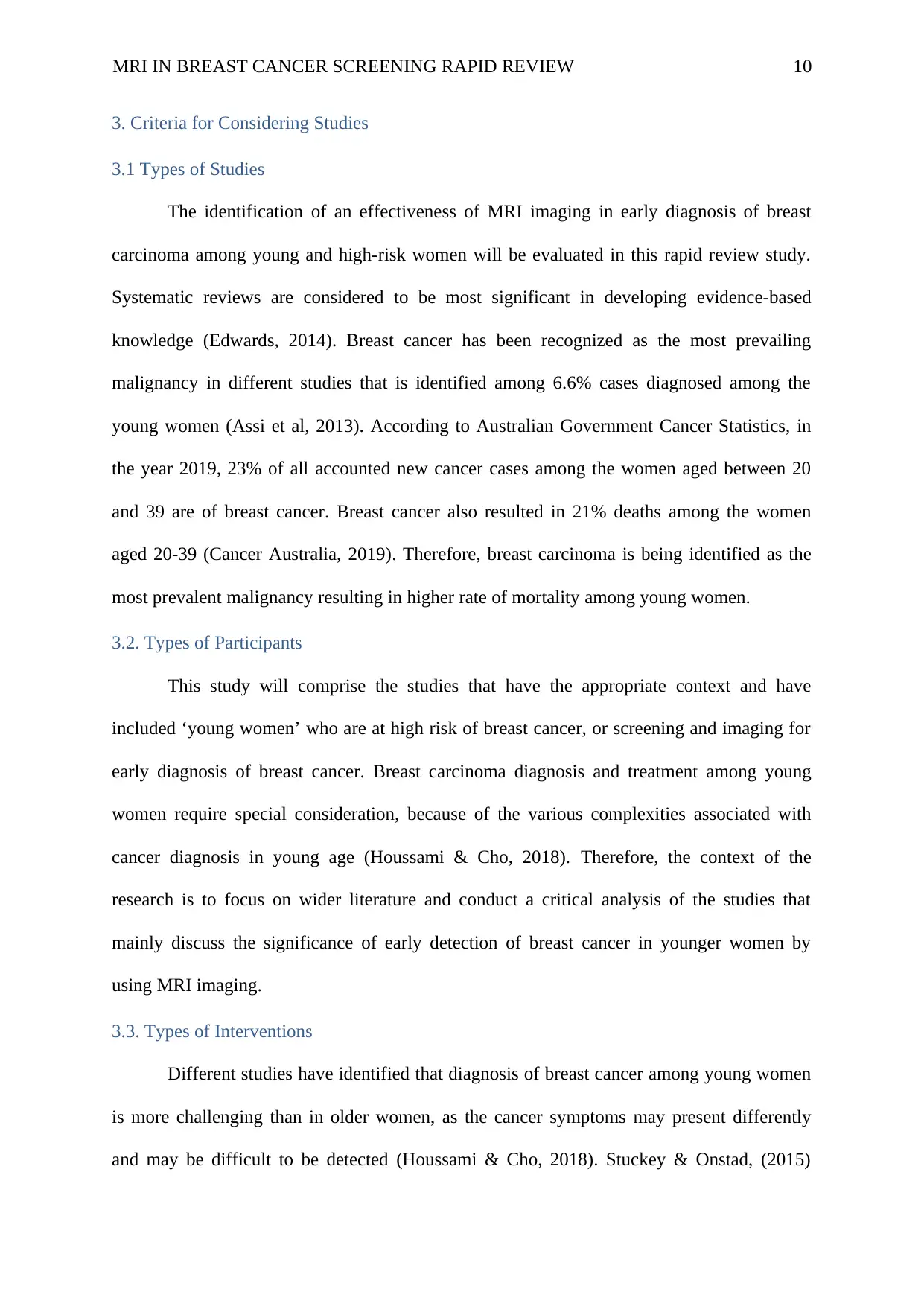
MRI IN BREAST CANCER SCREENING RAPID REVIEW 10
3. Criteria for Considering Studies
3.1 Types of Studies
The identification of an effectiveness of MRI imaging in early diagnosis of breast
carcinoma among young and high-risk women will be evaluated in this rapid review study.
Systematic reviews are considered to be most significant in developing evidence-based
knowledge (Edwards, 2014). Breast cancer has been recognized as the most prevailing
malignancy in different studies that is identified among 6.6% cases diagnosed among the
young women (Assi et al, 2013). According to Australian Government Cancer Statistics, in
the year 2019, 23% of all accounted new cancer cases among the women aged between 20
and 39 are of breast cancer. Breast cancer also resulted in 21% deaths among the women
aged 20-39 (Cancer Australia, 2019). Therefore, breast carcinoma is being identified as the
most prevalent malignancy resulting in higher rate of mortality among young women.
3.2. Types of Participants
This study will comprise the studies that have the appropriate context and have
included ‘young women’ who are at high risk of breast cancer, or screening and imaging for
early diagnosis of breast cancer. Breast carcinoma diagnosis and treatment among young
women require special consideration, because of the various complexities associated with
cancer diagnosis in young age (Houssami & Cho, 2018). Therefore, the context of the
research is to focus on wider literature and conduct a critical analysis of the studies that
mainly discuss the significance of early detection of breast cancer in younger women by
using MRI imaging.
3.3. Types of Interventions
Different studies have identified that diagnosis of breast cancer among young women
is more challenging than in older women, as the cancer symptoms may present differently
and may be difficult to be detected (Houssami & Cho, 2018). Stuckey & Onstad, (2015)
3. Criteria for Considering Studies
3.1 Types of Studies
The identification of an effectiveness of MRI imaging in early diagnosis of breast
carcinoma among young and high-risk women will be evaluated in this rapid review study.
Systematic reviews are considered to be most significant in developing evidence-based
knowledge (Edwards, 2014). Breast cancer has been recognized as the most prevailing
malignancy in different studies that is identified among 6.6% cases diagnosed among the
young women (Assi et al, 2013). According to Australian Government Cancer Statistics, in
the year 2019, 23% of all accounted new cancer cases among the women aged between 20
and 39 are of breast cancer. Breast cancer also resulted in 21% deaths among the women
aged 20-39 (Cancer Australia, 2019). Therefore, breast carcinoma is being identified as the
most prevalent malignancy resulting in higher rate of mortality among young women.
3.2. Types of Participants
This study will comprise the studies that have the appropriate context and have
included ‘young women’ who are at high risk of breast cancer, or screening and imaging for
early diagnosis of breast cancer. Breast carcinoma diagnosis and treatment among young
women require special consideration, because of the various complexities associated with
cancer diagnosis in young age (Houssami & Cho, 2018). Therefore, the context of the
research is to focus on wider literature and conduct a critical analysis of the studies that
mainly discuss the significance of early detection of breast cancer in younger women by
using MRI imaging.
3.3. Types of Interventions
Different studies have identified that diagnosis of breast cancer among young women
is more challenging than in older women, as the cancer symptoms may present differently
and may be difficult to be detected (Houssami & Cho, 2018). Stuckey & Onstad, (2015)
Paraphrase This Document
Need a fresh take? Get an instant paraphrase of this document with our AI Paraphraser
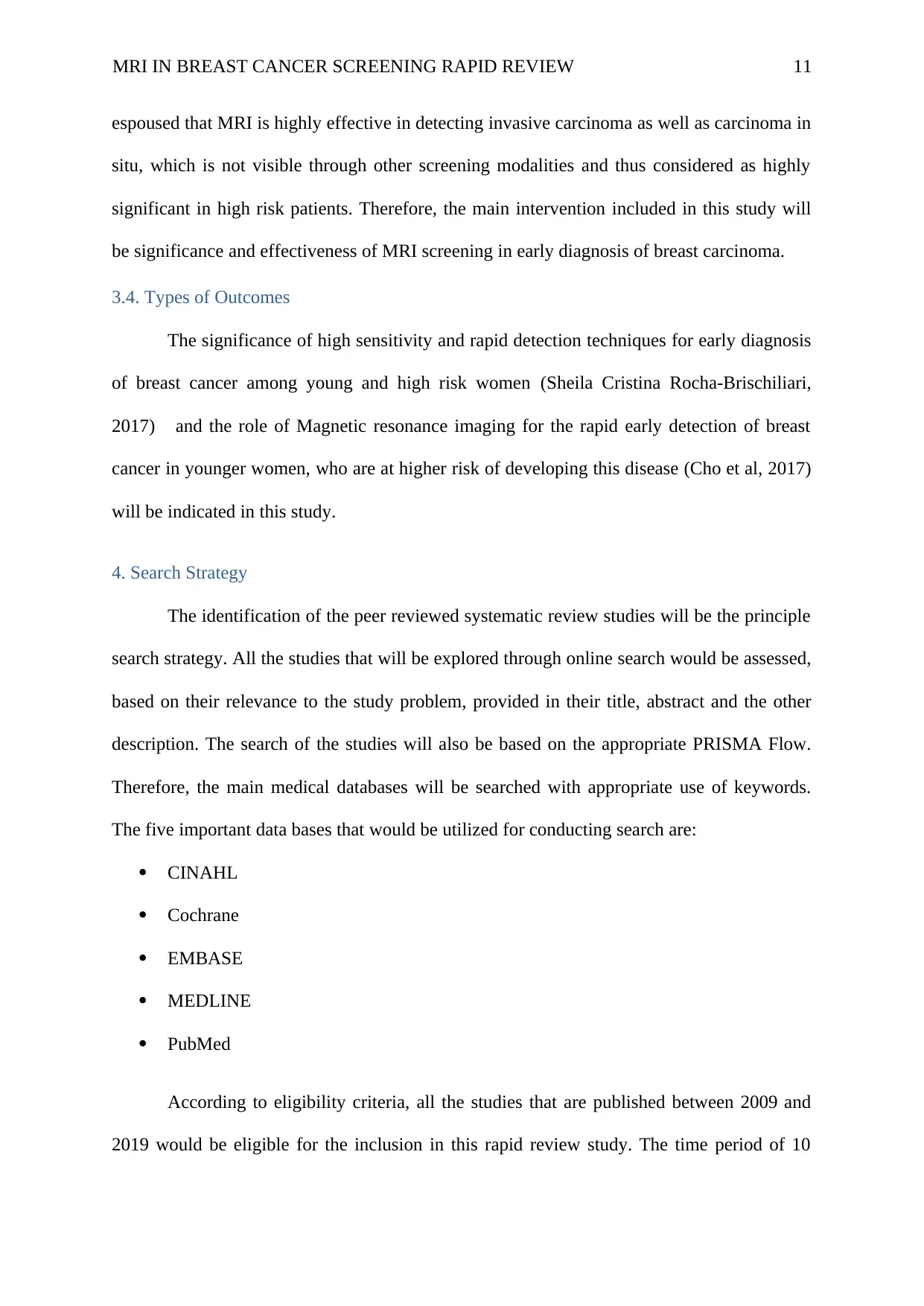
MRI IN BREAST CANCER SCREENING RAPID REVIEW 11
espoused that MRI is highly effective in detecting invasive carcinoma as well as carcinoma in
situ, which is not visible through other screening modalities and thus considered as highly
significant in high risk patients. Therefore, the main intervention included in this study will
be significance and effectiveness of MRI screening in early diagnosis of breast carcinoma.
3.4. Types of Outcomes
The significance of high sensitivity and rapid detection techniques for early diagnosis
of breast cancer among young and high risk women (Sheila Cristina Rocha-Brischiliari,
2017) and the role of Magnetic resonance imaging for the rapid early detection of breast
cancer in younger women, who are at higher risk of developing this disease (Cho et al, 2017)
will be indicated in this study.
4. Search Strategy
The identification of the peer reviewed systematic review studies will be the principle
search strategy. All the studies that will be explored through online search would be assessed,
based on their relevance to the study problem, provided in their title, abstract and the other
description. The search of the studies will also be based on the appropriate PRISMA Flow.
Therefore, the main medical databases will be searched with appropriate use of keywords.
The five important data bases that would be utilized for conducting search are:
CINAHL
Cochrane
EMBASE
MEDLINE
PubMed
According to eligibility criteria, all the studies that are published between 2009 and
2019 would be eligible for the inclusion in this rapid review study. The time period of 10
espoused that MRI is highly effective in detecting invasive carcinoma as well as carcinoma in
situ, which is not visible through other screening modalities and thus considered as highly
significant in high risk patients. Therefore, the main intervention included in this study will
be significance and effectiveness of MRI screening in early diagnosis of breast carcinoma.
3.4. Types of Outcomes
The significance of high sensitivity and rapid detection techniques for early diagnosis
of breast cancer among young and high risk women (Sheila Cristina Rocha-Brischiliari,
2017) and the role of Magnetic resonance imaging for the rapid early detection of breast
cancer in younger women, who are at higher risk of developing this disease (Cho et al, 2017)
will be indicated in this study.
4. Search Strategy
The identification of the peer reviewed systematic review studies will be the principle
search strategy. All the studies that will be explored through online search would be assessed,
based on their relevance to the study problem, provided in their title, abstract and the other
description. The search of the studies will also be based on the appropriate PRISMA Flow.
Therefore, the main medical databases will be searched with appropriate use of keywords.
The five important data bases that would be utilized for conducting search are:
CINAHL
Cochrane
EMBASE
MEDLINE
PubMed
According to eligibility criteria, all the studies that are published between 2009 and
2019 would be eligible for the inclusion in this rapid review study. The time period of 10
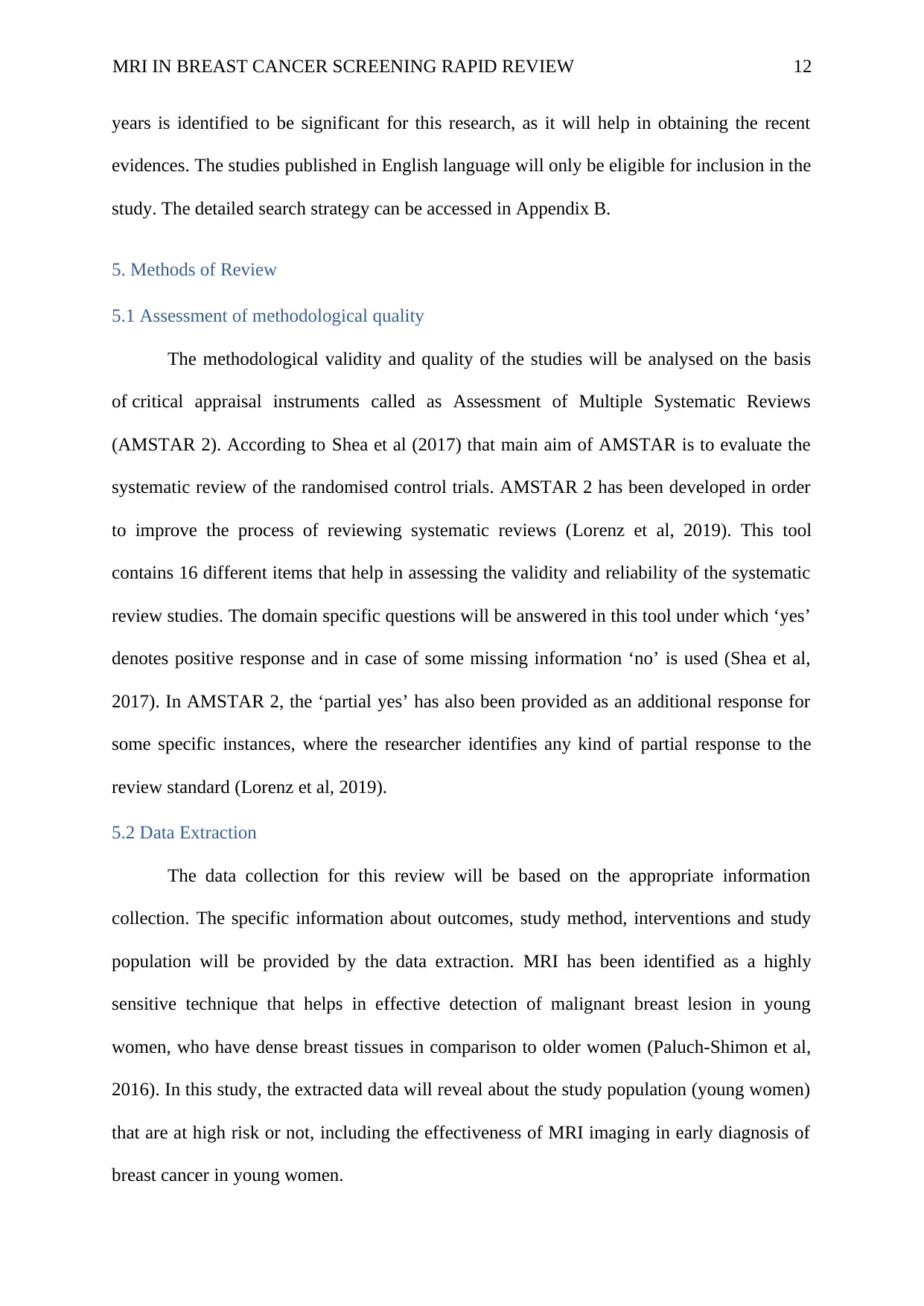
MRI IN BREAST CANCER SCREENING RAPID REVIEW 12
years is identified to be significant for this research, as it will help in obtaining the recent
evidences. The studies published in English language will only be eligible for inclusion in the
study. The detailed search strategy can be accessed in Appendix B.
5. Methods of Review
5.1 Assessment of methodological quality
The methodological validity and quality of the studies will be analysed on the basis
of critical appraisal instruments called as Assessment of Multiple Systematic Reviews
(AMSTAR 2). According to Shea et al (2017) that main aim of AMSTAR is to evaluate the
systematic review of the randomised control trials. AMSTAR 2 has been developed in order
to improve the process of reviewing systematic reviews (Lorenz et al, 2019). This tool
contains 16 different items that help in assessing the validity and reliability of the systematic
review studies. The domain specific questions will be answered in this tool under which ‘yes’
denotes positive response and in case of some missing information ‘no’ is used (Shea et al,
2017). In AMSTAR 2, the ‘partial yes’ has also been provided as an additional response for
some specific instances, where the researcher identifies any kind of partial response to the
review standard (Lorenz et al, 2019).
5.2 Data Extraction
The data collection for this review will be based on the appropriate information
collection. The specific information about outcomes, study method, interventions and study
population will be provided by the data extraction. MRI has been identified as a highly
sensitive technique that helps in effective detection of malignant breast lesion in young
women, who have dense breast tissues in comparison to older women (Paluch-Shimon et al,
2016). In this study, the extracted data will reveal about the study population (young women)
that are at high risk or not, including the effectiveness of MRI imaging in early diagnosis of
breast cancer in young women.
years is identified to be significant for this research, as it will help in obtaining the recent
evidences. The studies published in English language will only be eligible for inclusion in the
study. The detailed search strategy can be accessed in Appendix B.
5. Methods of Review
5.1 Assessment of methodological quality
The methodological validity and quality of the studies will be analysed on the basis
of critical appraisal instruments called as Assessment of Multiple Systematic Reviews
(AMSTAR 2). According to Shea et al (2017) that main aim of AMSTAR is to evaluate the
systematic review of the randomised control trials. AMSTAR 2 has been developed in order
to improve the process of reviewing systematic reviews (Lorenz et al, 2019). This tool
contains 16 different items that help in assessing the validity and reliability of the systematic
review studies. The domain specific questions will be answered in this tool under which ‘yes’
denotes positive response and in case of some missing information ‘no’ is used (Shea et al,
2017). In AMSTAR 2, the ‘partial yes’ has also been provided as an additional response for
some specific instances, where the researcher identifies any kind of partial response to the
review standard (Lorenz et al, 2019).
5.2 Data Extraction
The data collection for this review will be based on the appropriate information
collection. The specific information about outcomes, study method, interventions and study
population will be provided by the data extraction. MRI has been identified as a highly
sensitive technique that helps in effective detection of malignant breast lesion in young
women, who have dense breast tissues in comparison to older women (Paluch-Shimon et al,
2016). In this study, the extracted data will reveal about the study population (young women)
that are at high risk or not, including the effectiveness of MRI imaging in early diagnosis of
breast cancer in young women.
⊘ This is a preview!⊘
Do you want full access?
Subscribe today to unlock all pages.

Trusted by 1+ million students worldwide
1 out of 38
Your All-in-One AI-Powered Toolkit for Academic Success.
+13062052269
info@desklib.com
Available 24*7 on WhatsApp / Email
![[object Object]](/_next/static/media/star-bottom.7253800d.svg)
Unlock your academic potential
Copyright © 2020–2025 A2Z Services. All Rights Reserved. Developed and managed by ZUCOL.
